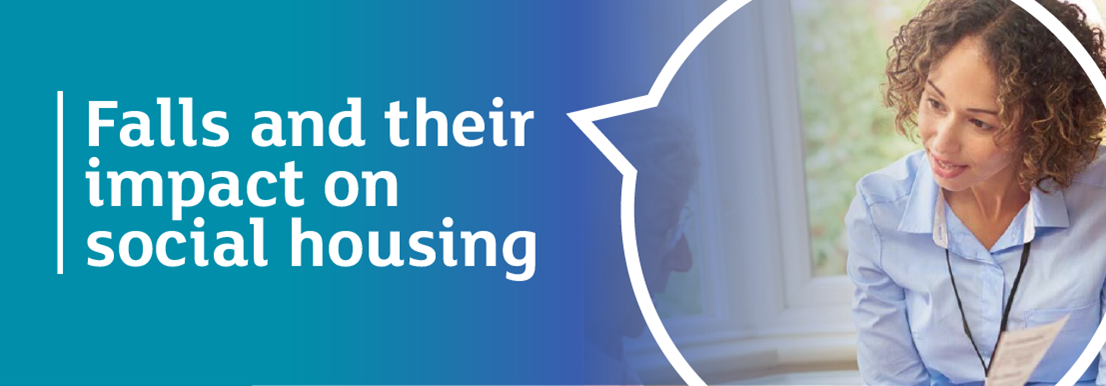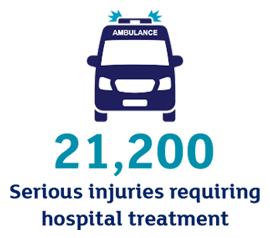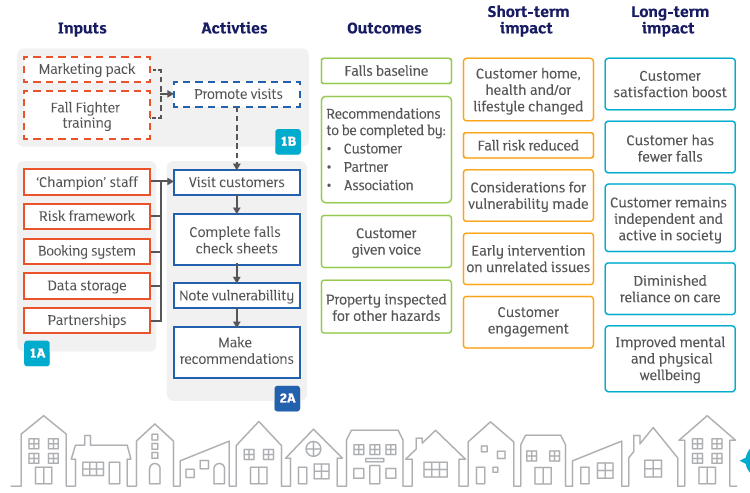
Falls and their impact on social housing
Falls are the biggest cause of accidental injury in the home, resulting in a staggering 80 per cent of hospital admissions for accidental injury to people aged 65 and over in the UK. Community-based studies suggest that one in three over-65s, and half of over-80s, will experience at least one fall every year.
RoSPA estimates 212,000 falls are suffered by older adults in England’s housing association households every year. This is thought to be a very conservative figure based on single occupancy households and without consideration of the disproportionate impacts of deprivation and poor health outcomes felt by social renters.
Download our toolkit here for free
Find out more about the impact of tenant falls on social housing landlords. Implement a proven fall prevention pathway to reduce falls by 69%
Costs and consequences
Falls impose an immeasurable burden on society through physical and psychological harm. Between 5 and 20 per cent of falls cause serious injuries - for example hip fractures or traumatic brain injuries. These often require expedited property adjustment, adaptation or relocation, placing a strain on housing services that is difficult to forecast and plan for.
Injuries, dampened confidence and lost independence can lead to property neglect and reliance on care and social support - all of which damage community adhesion. Some falls might trigger a negative spiral, leading to increased vulnerability, safeguarding issues, and further complexity to interactions between renter and their social landlord.
The growing problem of falls


Regulation for safe and appropriate homes
More than half of social homes house someone with a long-term illness or disability, the largest proportion of any tenure. Of all the personal attributes, functional characteristics and senses which can be impaired by long-term illness or disability, the single most widely affected is mobility. The number of over-65s households who lack the adaptations they feel they need has grown by over 100,000 in the past 10 years. (ref: English Housing Survey data 2021-22).
Recent damp and mould case law (known as Awaab’s Law) demonstrates how property condition may be implicated for its ill-health effects on vulnerable tenants. All Category 1 hazards can be considered under this law, including falls. Addressing fall risk is an opportunity for social landlords not only to avoid potential litigation but to ensure that homes are safe, secure and appropriate, aligning themselves with The Ombudsman’s expectations defined in The Charter for Social Housing.
Under renewed scrutiny from the Regulator for Social Housing in effect since April 2024, social landlords are now proactively assessed on their ability to recognise, respond and record the vulnerabilities of their customers. Whilst collating and maintaining up-to-date records poses a challenge, being equipped with this information places social landlords in the best position to understand the holistic needs of their tenants. They can factor vulnerabilities into housing and adaptations policy, examine how well their current stock meets needs and shape future developments accordingly. On an individual level, accurate vulnerability data allows rapid access to reasonable adaptations boosting tenant satisfaction, tenancy sustainment and empowering vulnerable tenants to remain independent.
The impact on housing
![]()
![]()
An opportunity
Based on a hugely successful pilot at Staffordshire-based housing association Trent & Dove, RoSPA has developed a toolkit aimed at reducing the impact of tenant falls in social housing. The model combines staff training, home safety checks and effective partnership working to address fall risks and facilitate a measurable reduction in number of falls suffered by participants.

Integrating falls prevention
✓ Safer, more appropriate homes
✓ Better tenancy sustainment
✓ Engagement with 'quiet homes'
✓ Improved relations with tenants
✓ Better performance against tenant satisfaction measures (TSM)
✓ Reducing under-occupation through discussion on down-sizing/right sizing
✓ Access to additional property adaptation funding e.g Disabled Facilities Grant (DFG)
✓ Understanding tenant vulnerabilities
✓ Environmental, Social and Governance (ESG) credentials for three key reporting themes: building safety and quality, resident voice and resident support
✓ Early intervention for property disrepair and safeguarding
✓ Staff engagement with home safety messaging
✓ Partnership working with local community services and Voluntary Community and Social Enterprises
Integrating falls prevention into their suite of tenant support services, social landlords will benefit in many different ways
The risk framework
The risk framework will guide staff to deliver a person-centred approach to fall risk reduction for each individual tenant. It comprises a review of health and lifestyle factors and an assessment of hazards in the home environment with consideration of all the vulnerabilities of the sitting tenant.
Recommended actions providing greatest holistic risk reduction are agreed between both the tenant and the staff. The tenant will then be empowered to make an effective and sustainable fall risk reduction with support from their social landlord and signposting to community partners and healthcare services.

The fall prevention framework
Before fall prevention framwork
After fall prevention framework


The toolkit contains
Our 3-component toolkit contains novel materials developed specifically for the social housing sector. We’ve included practical ideas to support tenants reduce their falls risk and home safety check sheets to ensure tenants are given consistent and reliable advice. A brand new version of Fall Fighter, RoSPA’s fall prevention awareness material, has be developed for frontline housing staff, helping them spot vulnerable tenants and signpost the fall prevention support available.
How to guide
A 32-page booklet to help housing providers integrate fall prevention pathways, provide an introduction to the risk framework and conduct effective customer engagement with safety messaging.
Fall Fighter for housing
Fall Fighter training presentation for housing staff, helping them to identify customers at risk and signpost home safety checks whilst also protecting friends and family at home.
Home safety templates
Home safety check sheet templates to structure the visits made to vulnerable tenants and collect data for showcasing a successful reduction of falls.
